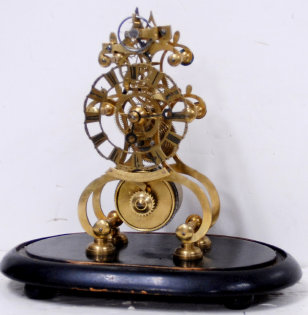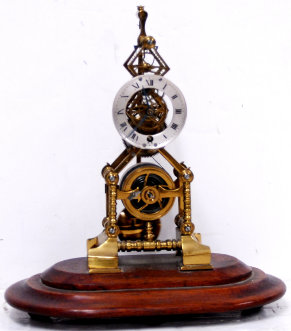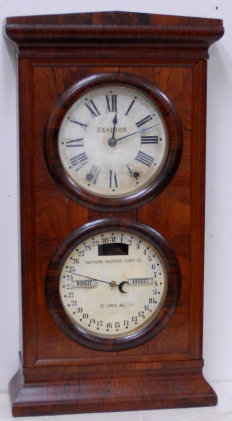

184. $3000
English Skeleton clock, 2 fusee, striking on a large gong on
the back and a nickel bell on top and attributed to Wm. F. Evans of Handsworth, England, ca 1860. Similar clocks can be found in Derek
Robert’s book, “British Skeleton Clocks”, page 148. The large clock is mounted to a wood base with turned brass feet underneath. The
double fusee 8-day movement is running but sluggish. As I mentioned with another skeleton clock in this collection they have been
in the basement of a Catholic church for years after they were left to the church by a parishioner. I have been surprised that any
of them attempted to run for they have not been serviced in decades. The clocks were shipped to us from west of the Rockies and during
that ride the original dome to this clock shattered in a million pieces. The large gong strikes the hours and the nickel bell sounds
the half hours. The clock mentioned in Robert’s book has an identical bell/gong strike system. A plaque attached to the wood case
reads, “Time is, Time was, Times past”. The clock, as pictured, stands 25 inches tall. The unusual pendulum with the wood stick, round
cylinder, and brass top and bottom, is 15 inches. Note the ivory skull attached to the strike advance cord. I laid it on top of the
wood base for the picture. The wheels have 6 spoke crossings and other rods and levers I cannot explain. $3000-$5000.

185. $300
Southern Calendar Clock Co. “Fashion No. 1”, ca 1875. Nice No. 1’s
are very hard to find. The No. 1’s were made with mahogany veneer and stood 28 ½” tall. The St. Louis, Mo. based company was operated
by the Culver brothers, Henry, Lucius and Wallace. They obtained movements from Seth Thomas Clock Company and in the beginning housed
them in veneered cases. As is generally the case, this one has a couple of small chips on the top but the rest of the case is good.
In fact, it may be better than any I have sold. Everything is original except the cutout in the calendar dial. I suppose Bubba wanted
to see the pendulum move. The dials show a little wear, but to be original they are not bad. Both movements are correct, good inside
label, pendulum bob, and overall not a bad No. 1. It looked better as I spent more time going over it. Ly-Calendar #669.
183. $250
Miniature brass skeleton timepiece, probably English made, not
signed anywhere. It is running but no doubt needs oiling. Mounted to a wood base with turned wood feet. The original glass dome has
a crack on the back side. I doubt this cracked dome is original to this clock, fit not so good. It is 9 inches tall, with dome 9 ½
inches tall. Very thin wire on the fusee. $300-$500.


186. $1150
E. Howard & Co., Boston, “Regulator No. 10” also known as
a “figure 8”. This clock is a more recent model and is in like new condition. The clock is walnut, 34” high. I removed the dial for
the picture and noticed the dial was painted by the “Dial House” in the 1990’s. The 8-day movement is weight driven and signed, “E.
Howard & Co. Boston”. The case has the proper door latch and pendulum bob, pendulum stick, an iron weight of the proper
size, and the brass pulley. The reproduction No. 10 Howards has generally been selling around $2500. Originals have been selling in
the $15,000 range so that is why the good copies are bringing good money. There are no numbers or dates to indicate who or when it
was made other than the dial being painted and the movement signed properly. $1250-$1500.
182. $350
English brass skeleton timepiece by “Simcock Warrington”, ca
1890. A plate below the dial has the makers name, Sincock, and his town, Warrington, engraved. This is a very nice subminiature skeleton
with nicely turned pillars and six spoke wheels. The chain fusee 8-day cylinder movement is running. This group of skeleton clocks
has been stored in the basement of a Catholic church for many years. This one was hesitant to run until I put a spot of oil on the
cylinder movement, then it took off running. No. 181 above started running without any hesitance. It is 11 inches tall without the
dome and 13 ½ inches with the original dome in place. The frame is mounted to a wood base with turned wood feet underneath. $500-$750.


187. $1000
Seth Thomas Clock Co. Double Dial calendar clock, “Parlor Calendar
No. 10”, ca 1896. This is the early model with acorn finials on the top four corners and a fancier trim on the base. The walnut case
should be 36” high and decorated top to bottom with carved objects, turned columns, grooves and etchings, applied wood trim, and various
shades of burl walnut. To me this is one of ST most elaborate cases and a great progression in case styles since their beginning in
the 1860’s. This case has been lightly cleaned and rubbed, and is just dark enough to have a nice aged look. As far as we can tell
it is complete except for the top trim. I will enclose photos of a near perfect No. 10 we sold last year. Any good cabinet man should
be able to complete the case for you. The dials have been professionally repainted by The Dial House with all names and trademarks
the originals would have had. The hands, rollers in the lower dial, brass bob, and two large iron weights, all look to be original.
The large weights descend each side of the case. The 8-day time movement and perpetual calendar movement are operating properly and
it strikes the hours on a cathedral bell. The bell is attached to a nickel gong base. On the inside of the door is a complete black
label and behind the calendar movement is the original white label. Ly-Seth Thomas, pages 110-111. In the past we have observed
this model selling as high as $10,000. Our estimate for this nice example is $1000-$1500.
